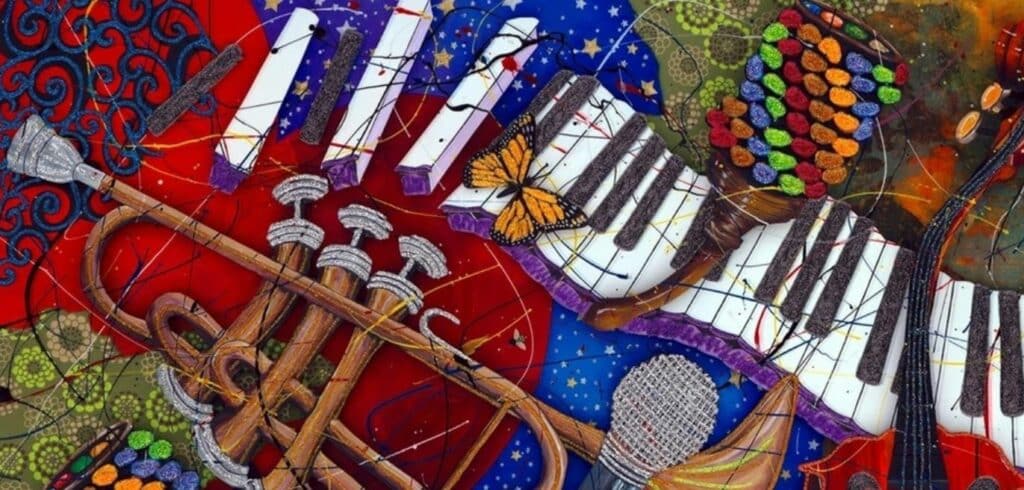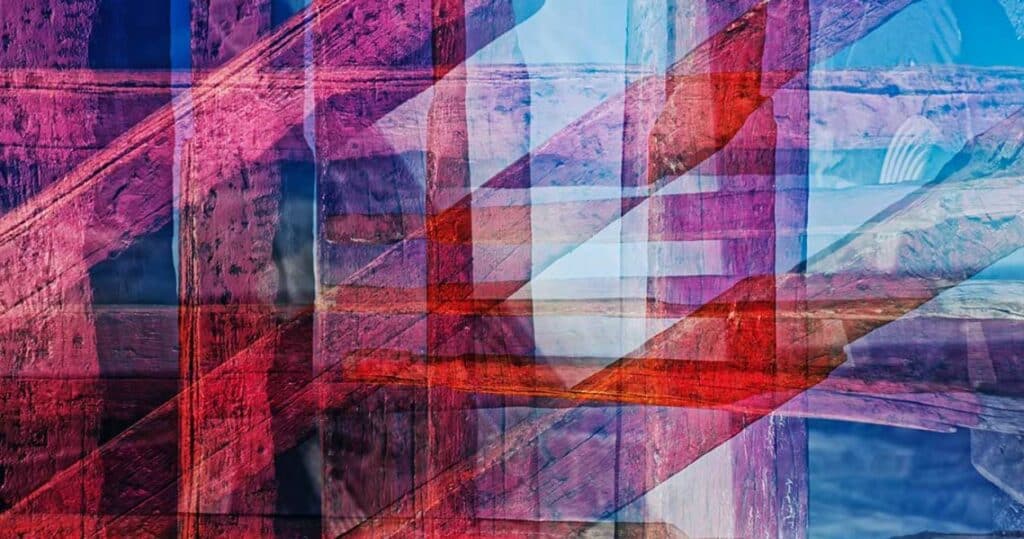“Where Melody Meets Canvas: Exploring the 10 Best Harmonious Connections Between Music and Visual Art”
Let’s get ready to start on an amazing adventure as we investigate “The Influence of Music on Visual Art: 10 Harmonious Connections,” the ten symbiotic relationships that exist between the fields of music and visual art.Artists have long drawn inspiration from the harmonies, beats, and emotions that music creates, translating these auditory sensations into stunning visual works of art.
Greetings, fellow admirers of the visual arts! Have you ever found yourself becoming lost in the vivid brushstrokes of a painting, experiencing the beat and harmony in each individual stroke? You’re not the only one, that’s for sure! Music and visual art have had a long and passionate history, one that is intricately entwined in a symphony of creative expression that is unrestricted by physical limitations.
People of all different cultures and backgrounds can communicate with one another through the medium of music because it is a language that knows no borders. Read more about music in different cultures in our article, “Famous Traditional Musical Genres”
10 Harmonious Connections of Music on Visual Art
These linkages demonstrate the complex nature of the relationship that exists between music and visual art. They also demonstrate how one form of artistic expression can effortlessly influence and inspire another, producing an experience that is layered, multifaceted, and immersive for art fans as well as spectators.The following are ten examples of how music and visual art are harmoniously connected:
1. Rhythm and Repetition

Artists frequently employ visual motifs throughout their work in order to generate a sense of movement and harmony within their creations. The recurring rhythmic patterns and themes that may be found in music served as motivation for the creation of these motifs.
Key Aspects: Rhythm and Repetition
| Aspects | Description |
| Beat: | Translating musical beats into repeated visual patterns. |
| Flow: | Creating a visual flow that echoes the rhythm of music |
| Pattern: | Utilizing repeated motifs and patterns to mirror musical rhythms. |
| Tempo: | Infusing visual elements with the tempo of a musical piece. |
| Pulse: | Echoing the pulse and cadence of music through visuals. |
| Movement: | Incorporating dynamic visual elements that reflect musical rhythm. |
| Harmony: | Achieving visual harmony through the repetition of specific forms. |
| Unity: | Creating a cohesive visual experience with repeated elements. |
2. Mood and Color Palette

It is typical for the emotional tones and themes in music to influence the choice of colors in visual art. This can happen for a variety of reasons. This assists in evoking specific feelings and situations that are designed to resonate with the viewer and is a useful tool.
Key Aspects: Mood and Color Palette
| Aspects | Description |
| Emotive Color Schemes: | Colors chosen to reflect the emotional tones of music. |
| Vibrant vs. Muted Tones: | Reflecting the contrast between lively and somber music. |
| Symbolic Color Choices: | Colors used symbolically to represent musical elements. |
| Harmonious Color Blends: | Creating visual harmony akin to musical chord progressions. |
| Dynamic Color Transitions: | Echoing the changes in musical dynamics and tempo. |
| Expressive Color Contrast: | Reflecting the highs and lows of musical expression. |
| Monochromatic Emotions: | Utilizing monochromatic schemes to evoke specific moods. |
| Chromatic Rhythms: | Visual rhythm created through strategic color placement. |
3. Narrative and Composition

Visual artists construct their works in such a way as to narrate a sequence of events or evoke a certain plot in order to take the viewer on a journey through the visual world. This is comparable to the way that certain pieces of music may tell a story.
Key Aspects: Narrative and Composition
| Aspects | Description |
| Storytelling: | Art’s ability to convey a narrative or story through composition. |
| Emotional Resonance: | Use of composition to evoke specific emotions and feelings. |
| Visual Flow: | Arrangement of elements to guide the viewer through the artwork. |
| Temporal Elements: | The creation of a sense of time and sequence within the composition. |
| Symbolism: | Utilization of symbols and motifs to communicate themes and ideas. |
| Contextual Interpretation: | The way viewers interpret the narrative context within the art. |
| Narrative Progression: | The portrayal of a storyline or development within the artwork. |
| Viewer Engagement: | The ability of composition to captivate and engage the audience. |
4. Abstraction and Melody

Abstract art seeks to capture the essence of musical expression through the use of non-representational forms and shapes, and the fluidity and melody of music can serve as a source of inspiration for abstract art.
Key Aspects: Abstraction and Melody
| Aspects | Description |
| Inspirational Source: | Melodic sequences inspire abstract visual forms. |
| Emotive Interpretation: | Abstraction conveys the emotional essence of melodies. |
| Fluid Forms: | Abstract art captures the flow and movement of music. |
| Non-representational Expression: | Melodies translated into non-figurative visual elements. |
| Dynamic Energy: | Abstract visuals reflect the energy of musical melodies. |
| Interpretive Freedom: | Artists interpret melodies abstractly with creative freedom. |
| Symbolic Representation: | Abstraction symbolizes the essence of musical compositions. |
| Expressive Intensity: | Abstract forms convey the intense emotions of musical melodies. |
5. Tempo and Brushstrokes

The tempo and rhythm of a musical composition can serve as a source of inspiration for artists, who can then be motivated to create a variety of brushstrokes, which can then reflect the intensity, passion, and emotion that are present in the song.
Key Aspects: Tempo and Brushstrokes
| Aspects | Description |
| Tempo variations: | Inspire varying brushstroke speeds |
| Energetic music: | Reflects dynamic and vigorous brushstrokes |
| Slow-paced melodies: | Encourage deliberate and intricate strokes |
| Syncopated rhythms: | Manifest as irregular and lively brushwork |
| Staccato beats: | Evoke short, abrupt, and precise brushstrokes |
| Legato passages: | Translate into smooth and fluid brush movements |
| Adapting musical phrasing: | Reflects changes in stroke length and direction |
| Shifts in musical dynamics: | Influence the intensity and pressure of brushstrokes |
6. Harmony and Balance

When creating works of art, artists frequently work toward producing a sense of visual harmony and balance in their compositions. This is similar to the manner in which musical harmony contributes to the overall sense of coherence and unity in a piece.
Key Aspects: Harmony and Balance
| Aspects | Description |
| Concept of Unity: | Creating visual cohesion and unity, mirroring musical harmony. |
| Symmetry: | Balancing elements symmetrically to achieve visual equilibrium. |
| Spatial Harmony: | Arranging elements within space to establish a harmonious flow. |
| Complementary Colors: | Using contrasting colors that balance and harmonize the composition. |
| Golden Ratio: | Applying mathematical ratios to create pleasing proportions. |
| Counterpoint: | Incorporating visual counterpoints that evoke musical interplay. |
| Emotional Resonance: | Eliciting emotional responses through harmonious visual arrangements. |
| Flow and Continuity: | Ensuring a smooth flow and continuity, akin to a musical melody. |
7. Genre Fusion in Mixed Media

Combining different types of music can inspire artists to experiment with a variety of different mediums. The blending of various musical genres can inspire artists to experiment with a wide variety of creative materials, which can lead to one-of-a-kind and unique visual expressions that are reflective of the diverse character of music.
Key Aspects: Genre Fusion in Mixed Media
| Aspects | Description |
| Integration of mediums: | Blending various artistic mediums for a multi-dimensional effect |
| Diversity of expression: | Reflecting the diversity and complexities of musical genres through visual representation |
| Experimental techniques: | Exploring innovative approaches to create dynamic and eclectic artworks |
| Synthesis of elements: | Combining musical themes, symbols, and motifs with visual imagery |
| Interdisciplinary fusion: | Incorporating elements from different art forms for a holistic artistic experience |
| Narrative complexity: | Creating layered narratives by integrating elements from diverse genres |
| Symbolic resonance: | Using mixed media to convey deeper symbolic meanings and associations |
| Aesthetic hybridization: | Merging different art styles and techniques to produce unique and hybrid visual expressions |
8. Influence of Music on Sculptural Forms

The characteristics of sculptural works, such as their shape, motion, and energy flow, Sculptors can draw creativity from music, which can influence the shape, motion, and dynamic features of their works of art, providing an auditory component to their visual art. Music can also serve as a source of inspiration for architects and interior designers. Music has the potential to inspire sculptors in a variety of ways.
Key Aspects: Influence of Music on Sculptural Forms
| Aspects | Description |
| Musical Inspiration: | Music inspires sculptors, influencing form and dynamics. |
| Conveying Rhythm: | Sculptures may capture the rhythm and tempo of music. |
| Dynamic Qualities: | Music infuses sculptural works with energy and movement. |
| Emotional Resonance: | Sculptural forms reflect the emotional essence of music. |
| Interplay of Space and Sound: | Sculptors consider the relationship between space and sound in their creations. |
| Abstract and Conceptual Influence: | Music can inspire abstract and conceptual sculptural forms. |
| Fusion of Sensory Experiences: | Combining music and sculpture creates multi-sensory art. |
| Audience Engagement: | Sculptural works influenced by music engage viewers on a deeper level. |
9. The Concept of Silence in Visual Representation

The Concept of Void in the Representation of Visual Information Visual artists can incorporate the idea of silence in music into their works by utilizing negative space and minimalism to depict feelings of reflection, tranquility, or anticipation. This is similar to the way that silence is used in music.
Key Aspects: The Concept of Silence in Visual Representation
| Aspects | Description |
| Use of negative space: | Employing emptiness to convey depth and meaning. |
| Minimalist techniques: | Emphasizing simplicity and essential elements. |
| Contemplative mood: | Involving introspection and emotional reflection. |
| Symbolic representation: | Using silence as a symbol for profound concepts. |
| Subtle visual cues: | Communicating nuanced messages through imagery. |
| Evocation of tranquility: | Creating a sense of calm and serenity. |
| Enhanced focus: | Directing attention to specific visual elements. |
10. Sensory Perception and Cross-modal Synthesis

Multi-Sensory Experiences Can Be Produced When Music and Visual Art Are Combined The combination of music and visual art can provide an experience that is multi-sensory. In this kind of interaction, the combination of auditory and visual cues amplifies the overall aesthetic effect, which in turn engages the viewer on a deeper level.
Key Aspects: Sensory Perception and Cross-modal Synthesis
| Aspects | Description |
| Fusion of Senses: | Integration of auditory and visual stimuli |
| Emotional Resonance: | Eliciting emotional responses through combined sensory experience |
| Enhanced Engagement: | Creating a deeper connection with the audience |
| Multi-dimensional Expression: | Offering a multi-faceted and immersive artistic encounter |
| Synesthetic Interpretation: | Encouraging synesthetic interpretations and perceptions |
| Cognitive Stimulation: | Stimulating cognitive responses through combined sensory input |
| Aesthetic Fusion: | Blending auditory and visual elements for an aesthetic synergy |
| Immersive Artistry: | Providing a holistic and captivating artistic experience |
Not only does the compelling interaction between music and visual art enhance the creative process, but it also encourages a greater awareness of the complex relationships between human expression and the arts. The harmonious linkages between these two artistic domains continue to inspire and energize the worldwide artistic landscape, transcending cultural and geographical borders in the process. This can be seen in anything from the rhythmic cadence of a symphony to the brilliant hues of a painting.
FAQ
Can music have a real impact on the creative process in visual art?
Absolutely! Music’s emotional and psychological impact is frequently used as a catalyst in the creative process of visual art, altering the artist’s vision and generating unique interpretations.
How may musical aspects be properly incorporated into visual artwork?
Color schemes, textures, and compositions that mimic the mood, speed, or story of a certain musical work can be used to combine musical elements into visual art. Furthermore, experimenting with mixed-media techniques and multidisciplinary approaches can result in dynamic and immersive artistic experiences.
Are there any specific historical examples of music having a substantial influence on visual art movements?
Certainly! The emergence of abstract expressionism in the early twentieth century, driven by jazz music’s free-flowing improvisation, is a famous example. Furthermore, various artistic movements, such as Romanticism and Symbolism, were inextricably linked with the musical spirit of their respective times, demonstrating music’s ongoing influence on visual art throughout history.





